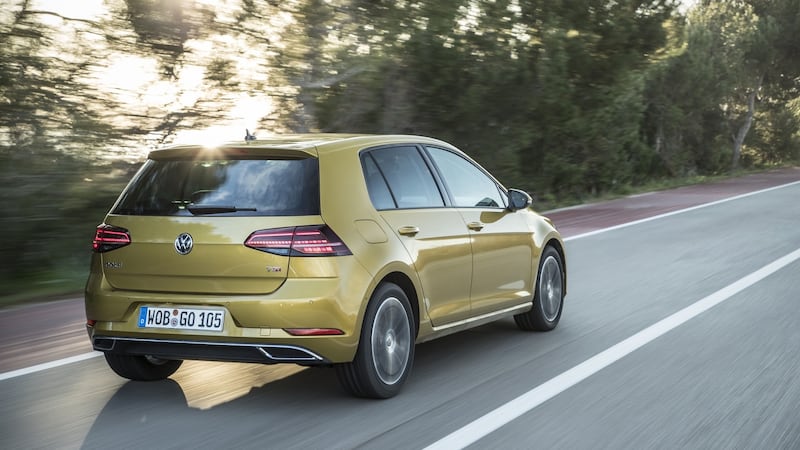Gone in 40 seconds: that’s the time it takes to sell a Golf somewhere in the world. It’s the staggering claim by Volkswagen about its best-selling car, and the only hatchback that can arguably deserve the adjective “iconic”.
The Golf overtook the Beetle a few years ago as the biggest selling model to carry the VW badge. Hardly surprising given the firm says 2,700 Golfs drive off the production line every 24 hours. What’s more, it has established itself as the benchmark for middle-class family hatchbacks.
Now in its seventh generation, it’s time for a mid-life update. These are often billed as facelifts, but the styling changes to the Golf are so subtle, you’d need a doctorate in German hatchbacks to spot them. Basically it comes with full LED rear lights, the most evident change.


Rather this is merely a move to update the car in line with the major shifts in technology under way. That means improved colour touchscreens, the option of a 12.3-inch active info display – a digital dashboard like that on offer on the Passat range – and option of gesture control.
That last feature lets you change screens at the swipe of your hand. Or so they say. I have yet to see it work properly. Like all such systems, you have to wonder how much extra effort is required in touching the screen rather than frantically waving your hand in front of it. On the Golf it could really do with a return to prope old-school buttons and knobs.
Powertrain options
Similarly, the bigger colour touchscreen is impressive aesthetically but I’d have preferred a few more solid button controls to remain, for things like volume control or calling up sat-nav.
VW claims the Golf is the only car in its class to offer a full gambit of powertrain options, from petrol to diesel and hybrid to electric. New to the engine range for the upgrade is the replacement of the smallest petrol engine. Out goes the 1.2-litre with 85bhp or 110bhp and in comes a 1-litre with the same output options. The car will also come with a 1.4-litre petrol early in its rollout and later a 1.5-litre petrol. Then there is a 1.6-litre diesel in 90bhp or 115bhp, and a 2-litre 150bhp diesel.
Arriving in March, prices start at €20,895 for the entry-level grade three-door 1-litre 85bhp petrol but in reality few will opt for this car. Instead the real starting point for the new Golf will be the more powerful 110bhp iteration of that 1-litre petrol engine at €21,895 for the three-door model. Five-door versions cost an extra €1,000.
The big volume sales will be this petrol and the 1.6-litre diesel, which starts at €22,995 for the three-door 90bhp or €23,995 for the 115bhp version. Those price differences mean a price increase on the outgoing models of about €500.
Better equipment levels
Given its middle-class credentials it’s hardly surprising that buyers are opting for better equipment levels, but it was not always the case. Back in 2012, it was 39.6 per cent entry grade, but by 2016 that has flipped to 40.9 per cent of buyers opting for the highest grade. In money terms, the step up from entry to mid-level Comfortline is €1,900, while from there to the top Highline grade is a further €2,500.
Part of the reason for the greater pick-up in higher specification has been the popularity among buyers of Volkswagen's Personal Contract Plan finance packages. Last year, 70 per cent of all Golfs sold were financed through Volkswagen Bank, of which 80 per cent were on PCP deals. That's roughly 2,800 of the 5,000 or so Golfs sold in Ireland in 2016. For a few euros a month extra buyers are making the move upmarket.
While the new Golf will start arriving in Ireland from March, later in the spring the likes of the new GTI, GTD and electric e-Golf will arrive here. The electric Golf promises a 50 per cent increase in range, which means an official figure of close to 300km, but in reality that’s likely to be 200km between charges for motorists.
While we got to test the 2-litre 150bhp diesel - a worthy consideration if you do a lot of motorway driving - the most fun was in the latest generation GTi. It might not be the hottest hatch out there, but it’s certainly the most well-rounded. Whether weaving through the bends on tight and twisting back roads, or working through traffic, time spent in the GTi makes you wonder why executives without big families would opt for a cookie-cutter premium saloon over this. Prices have yet to be confirmed but expect the turbocharged 2-litre 226bhp to come in just under €40,000.
Ultimately the updated Golf loses none of the recipe that has made it a sales success to date, but brings the in-car technology into line with advances in the market. The world may be turning to SUVs and crossovers, but there’s plenty of road left in the Golf range just yet.


















